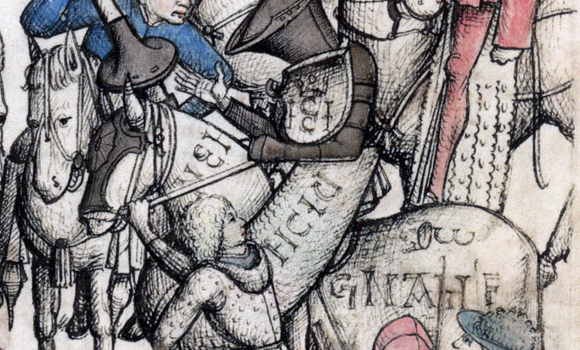C09 |
Inscription of the Body: Text and Body in pre-modern Iberian literature |
current staff members
| Teilprojektleiter | Prof. Dr. Robert Folger |
| akademische Mitarbeiterin | Dr. Stephanie Béreiziat-Lang |
| akademische Mitarbeiterin | Dr. Marina Aurora Garzón Fernández |
former staff members
| akademische Mitarbeiterin | Felicitas Loest |

Das Teilprojekt zu ‚Körperbeschriftungen‘ untersucht Zusammenhänge zwischen der Materialität des Geschriebenen, den Konzeptionen von Körperlichkeit und den Praktiken des Schreibens in den mittelalterlichen und frühneuzeitlichen Literaturen des iberischen Raums (14. bis 16. Jahrhundert). Zum einen stellen literarische Texte verschiedener Gattungen (novela caballeresca, novela sentimental, aber auch Epik, historiographische, philosophisch/doktrinäre und mystische Texte) einen Bezug zwischen schrifttragenden Artefakten und dem Körper her, indem sie mit dem Körper in Verbindung stehende beschriftete Dinge (Kleidung, Rüstung etc.) evozieren. Zum anderen werden auf metaphorischer Ebene und auf der Ebene der Erzählung Analogien zwischen der Beschriftung und dem Artefaktcharakter des Körpers und der Körperhaftigkeit der Schrift hergestellt. Die fiktionale Modellierung von Körperbeschriftungen in literarischen Texten bietet so metatextuelle Einblicke in das Imaginarium möglicher kultureller Praxeologien, in Konzeptionen von Subjektivität und die Rolle des Geschriebenen an der Schwelle zum Druckzeitalter.
In der abschließenden Förderperiode wird die diachrone Perspektive anhand von zwei Untersuchungsfeldern vertieft, die exemplarisch für die Gemengelage von vortypographischer materieller Schriftlichkeit und modernen Schriftkonzeptionen stehen: die Mystik und die frühe Kolonialliteratur. So werden die sich wandelnden Funktionen von Körperbeschreibungen am Übergang von der präsentischen Kultur des Mittelalters zur Neuzeit erfasst, in der die materiale Textualität zunehmend von modernen Repräsentationsformen und einem modernen Textverständnis überlagert wird. Durch die Untersuchung des epistemischen Status von Schrift und Körper und ihres Verhältnisses zueinander zwischen Vormoderne und Früher Neuzeit soll das Phänomen der ‚Körperbeschriftungen‘ gattungsübergreifend und diachron systematisiert werden, um so zu einer Poetik somatischer Schriftlichkeit in historischer Perspektive beizutragen.
Projektrelevante Publikationen
- [Béreiziat-]Lang, Stephanie (2017): „Von bezeichneten Körpern und beschrifteten Schuhen – ‚Körperschrift‘ und Narration in iberischen Literaturen des 14. und 15. Jahrhunderts“, in: Ludger Lieb, Stephan Müller u. Doris Tophinke (Hgg.), Graffiti. Deutschsprachige Auf- und Inschriften in sprach- und literaturwissenschaftlicher Perspektive (Stimulus. Mitteilungen der Österreichischen Gesellschaft für Germanistik 24), Wien, 77–108.
- Béreiziat-Lang, Stephanie (2017): „Der ›Ekel‹ des Schreibens bei Jean-Paul Sartre. Von der Ohnmacht der Worte und der Macht des weißen Papiers“, in: Böttner, Michaela / Lieb, Ludger / Vater, Christian / Witschel, Christian (Hgs.): 5300 Jahre Schrift, Heidelberg: Wunderhorn, 158-161.
- Béreiziat-Lang, Stephanie (2018), „Tirant lo Blanc – Del poder de las palabras al gobierno del signo vacío“, in: Christoph Strosetzki (Hrsg.): Aspectos culturales del hispanismo mundial. Literatura – Cultura – Lengua. (Actas del XIX congreso de la AIH), Berlin: De Gruyter, 402-413.
- Béreiziat-Lang, Stephanie (2018), „Espejos distorsionados – usurpación de poder y subversión literaria en Tirant lo Blanc“, in: Iberoromania 88, 115-134.
- Béreiziat-Lang, Stephanie (2018): „Körper versus Schrift? Mystische Erfahrung als intertextuelle Polyphonie im Boosco deleitoso (1515)“, in: Lusorama 107-108, 5-36.
- Béreiziat-Lang, Stephanie: „Materialización y metapoética desde las novelas caballerescas a la épica colonial“, in: Béreiziat-Lang, Stephanie / Ortiz Gambetta, Eugenia / Navascués, Javier (Hgs.): Textos permeables. Estructuras y estrategias de la épica hispánica (siglos XV-XVII). Número monográfico de Rilce: Revista de Filología Hispánica 36.1, 2020, S. 52-75.
- Béreiziat-Lang, Stephanie: „Inscriptions on the Iberian Peninsula. Material scripture and narrative logic in Castilian and Catalan Literatures”, in: Wagner, Ricarda / Neufeld, Christine / Lieb, Ludger (Hgs.): Writing beyond Pen and Parchment: Inscribed Objects in Medieval European Literature, Berlin/Boston: De Gruyter [Reihe Materiale Textkulturen], ersch. 2019.
- Béreiziat-Lang, Stephanie/Ott, Michael R.: „Body and Skin. The Corporeality of writing“, in: Wagner, Ricarda / Neufeld, Christine / Lieb, Ludger (Hgs.): Writing beyond Pen and Parchment: Inscribed Objects in Medieval European Literature, Berlin/Boston: De Gruyter [Reihe Materiale Textkulturen], ersch. 2019.
- Béreiziat-Lang, Stephanie/Ortiz Gambetta, Eugenia/de Navascués, Javier (eds.): Textos permeables. Estructuras y estrategias de la épica hispánica (siglos XV-XVII). Número monográfico de Rilce: Revista de Filología Hispánica 36.1, 2020.
- Béreiziat-Lang, Stephanie/Folger, Robert/Palacios Larrosa, Miriam(eds.): Escritura somática. La materialidad de la escritura en las literaturas ibéricas de la Edad Media a la temprana modernidad, Leiden: Brill, 2020.
- Béreiziat-Lang, Stephanie: „Beschriebene Wilde und verwildertes Schreiben – Zur Verschriftlichung ‚anderer‘ Gesellschaftlichkeit bei Rousseau und Lévi-Strauss“, in: Loy, Benjamin/Oberto, Simona/Strohmaier, Paul (eds.): Imaginationen des Sozialen. Narrative Verhandlungen zwischen Integration und Divergenz (1750-1945), Heidelberg: Winter [Studia Romanica], 2020, S. 83-106.
- Béreiziat-Lang, Stephanie/Folger, Robert/Palacios Larrosa, Miriam: „Introducción: Escribir sobre cuerpos“ in: Béreiziat-Lang, Stephanie/Folger, Robert/Palacios Larrosa, Miriam (Hgs.): Escritura somática. La materialidad de la escritura en las literaturas ibéricas de la Edad Media a la temprana modernidad, Leiden: Brill, 2020, S. 1-15.
- Béreiziat-Lang, Stephanie: „Compensaciones entre cuerpo y escritura en Teresa de Cartagena“, in: Béreiziat-Lang, Stephanie/Folger, Robert/Palacios Larrosa, Miriam (Hgs.): Escritura somática. La materialidad de la escritura en las literaturas ibéricas de la Edad Media a la temprana modernidad, Leiden: Brill, 2020, S. 101-127.
- Enderwitz, Susanne/Folger, Robert/Sauer, Rebecca (2015), „Einweben und Aufnähen“, in Meier, Thomas / Ott, Michael R./ Sauer, Rebecca (Hgs.), Materiale Textkulturen. Konzepte – Materialien – Praktiken (Materiale Textkulturen 1), Berlin/München/Boston, 567-583.
- Folger, Robert (2016), „Die Imagination der Materialität: Das Liebesgefängnis (Cárcel de amor 1492), Metatextualität und soziale Praxis“, in: Friedrich-Emanuel Focken u. Michael R. Ott (Hgs.), Metatexte: Erzählungen von schrifttragenden Artefakten in der alttestamentlichen und mittelalterlichen Literatur (Materiale Textkulturen 15), Berlin/München/Boston, 217-238.
- Folger, Robert (2016), „Interpersonal and commodity fetishism in Cárcel de amor and Lazarillo de Tormes”, Special Issue: Nuevas aproximaciones al canon español de la temprana edad moderna, hg. v. R. Trillia u. R. Minic-Vidovic. Revista Canadiense de Estudios Hispánicos 41.1, 169-191.
- Folger, Robert (2017), „Subjectivity and hermeneutics in Medieval Iberia: the example of the Libro de buen amor“, in: J. Muñoz-Basols, L. Lonsdale u. M. Delgado (Hgs.), The Routledge Companion to Iberian Studies, New York/London: Routledge, 105-117.
- Folger, Robert (2018), „La escritura ‚semiculta‘ y la producción de la subjetividad literaria“, in: Studi Ispanici 53, 155-170.
- Folger, Robert/Lang, Stephanie (2016): „Texturen: Gewobene Liebesschwüre”, in: Spektrum der Wissenschaften Spezial Archäologie, Geschichte, Kultur 3, 82-85.
Datenbank
Mitarbeit an der Sammlung und Aufbereitung von Belegstellen von erzählten Inschriften in der Literatur des 12. bis 17. Jahrhunderts (TP C05): https://inschriftlichkeit.materiale-textkulturen.de.
Veranstaltungen und Gastvorträge am Teilprojekt
- Gastvortrag von Juan Pablo Mauricio García Álvarez: „Configuración de una cultura del texto breve y sus soportes materiales en las novelas de caballerías“, 16.11.2016.
- Gastvortrag von Folke Gernert (Trier): „Die Lesbarkeit des Körpers im Libro de buen amor (1330/1343) des Arcipreste de Hita“, 08.12.2016.
- Internationale Tagung „Cuerpo-Texto-Material en las literaturas ibéricas premodernas/Körper-Text-Material in den iberischen Literaturen des Mittelalters“, Heidelberg, 23.-24. Juni 2017.
- Mercator-Fellowship von Adrián Sáez (Université de Neuchâtel): April-Juni 2018, Forschungsaufenthalt und wissenschaftlicher Austausch zum Thema „Materialität der Schrift in Theater und frühem Roman des Siglo de Oro“.
- Mercator-Fellowship von Eugenia Ortiz Gambetta (Universidad Nacional de la Plata): 21.1.-23.2.2019, Forschungsaufenthalt und wissenschaftlicher Austausch zum Thema Materialität der Schrift im frühen kolonialen Kontext und alternativer Schriftlichkeit in ‚non-typographischen‘ Gesellschaften.
Vorträge, Workshops und Interdisziplinäres
- Béreiziat-Lang, Stephanie: Teilnahme an der Interdisziplinären Tagung (C05): „Graffiti. Auf- und Inschriften in sprach- und literaturwissenschaftlicher Perspektive“ in Paderborn, 5.-7.11. 2015.
- Folger, Robert: Gastvortrag an der Universität Augsburg: „Gute Liebe und schlechte Angewohnheiten: Formen des Selbst im Mittelalter, El libro de buen amor“, 28.10.2015.
- Interdisziplinärer Workshop der AG ‚Metatexte‘ (A01, B12, C02, C05, C06, C09) und des Freiburger Graduiertenkollegs 1767: „Erzählte schrifttragende Artefakte: Fakten und Fiktionen“ (Org. Friedrich- Emanuel Focken); Stephanie Béreiziat-Lang: Vortrag zu „Metatextualität und Selbstreferenzialität in den Chroniken von Jaume I und Pere III“, Heidelberg, 12.11.2016.
- Béreiziat-Lang, Stephanie und Eugenia Ortiz Gambetta (CONICET-Universidad Nacional de La Plata): Tagungssektion am 21. Deutschen Hispanistentag zum Thema „Textos permeables. modelos épicos y migración de imaginarios en la narrative hispánica, siglos XV-XVII“ in München, 29.03.-2.04.2017.
- Béreiziat-Lang, Stephanie: Teilnahme am interdisziplinären Workshop (C05): „Erzählte Inschriften und außergewöhnliche Formen von Geschriebenem in erzählenden Texten des europäischen Mittelalters“ in Heidelberg, 15.07.2016.
- Béreiziat-Lang, Stephanie: „Letras virtuales. Acerca de la agencialidad de los signos en las narrativas caballerescas “, Vortrag beim Congreso de la AISO, Madrid, Universidad Complutense, 10.-14.07.2017.
- Béreiziat-Lang, Stephanie: „Anatomías textuales y escritura del cuerpo en Teresa de Ávila“, Vortrag am Workshop „Textualizaciones del cuerpo y la salud“ in Trier, 16.01.2018.
- Folger, Robert: Gastvortrag an der Universidad Autónoma de Querétaro, Centro Universitario del Sur (México): “Inscripciones corporales: texto y cuerpo en las literatura ibéricas premodernas”, 05.2018.
- Folger, Robert: Gastvortrag an der Universidad de Guadalajara (México): “La escritura ´semiculta´ y la producción de la subjetividad literaria”, 05.2018.
- Folger, Robert: Gastvortrag an der Universidad de Guanajuato (México): “La escritura ´semiculta´ y la producción de la subjetividad literaria”, 05.2018.
- Folger, Robert: „Escritura material y colonialidad“, Vortrag im Rahmen der Conference „Dinámicas – transformaciones – perspectivas: Planteamientos actuales sobre las literaturas y culturas latinoamericanas”, Universität Konstanz, 5.-7.07.2018.
- Congreso de la Plataforma Hispano-Alemana ‘Ciencias de la vida y literatura en la temprana modernidad’, Heidelberg, 22.-23.11.2018.
- Vorträge: Robert Folger: “El problema de Villalobos: ciencia y escritura de sí”;
- Stephanie Béreiziat-Lang: “Anatomías textuales en Teresa de Ávila”.


